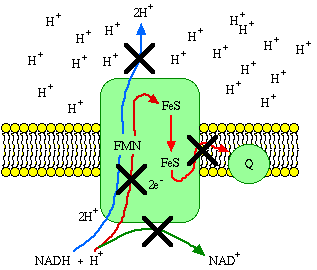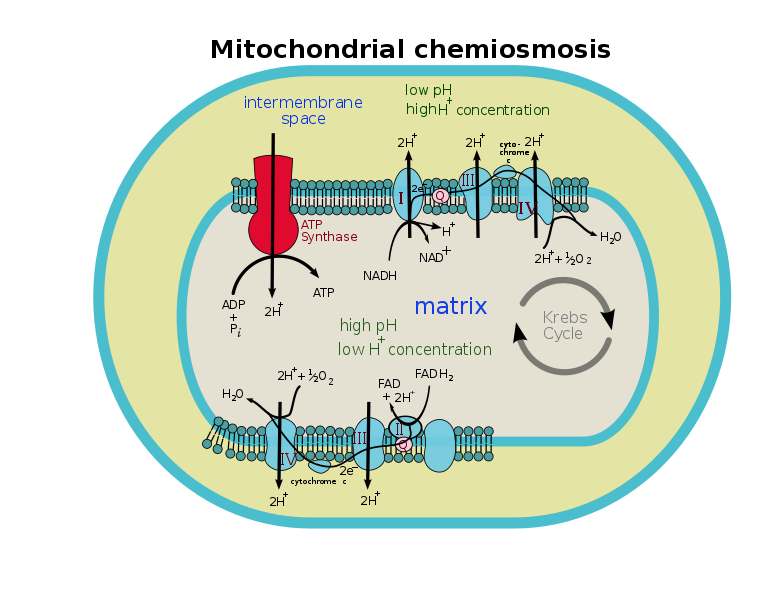In mitochondria and chloroplasts proton gradients are used to generate a chemiosmotic potential that is also known as a proton-motive force. Only in the final catabolic reactions that take place on the inner mitochondrial membrane is molecular oxygen O 2 directly consumed.

Mitochondria Function The Chemiosmotic Gradient
Chemiosmosis is defined as the movement of ions down an electrochemical gradient across a selectively permeable membrane.

. This potential energy is used for the synthesis of ATP by oxidative phosphorylation or photophosphorylation respectively. Relating to or being a theory that seeks to explain the mechanism of ATP formation in oxidative phosphorylation by mitochondria and chloroplasts without recourse to the formation of high-energy intermediates by postulating the formation of an energy gradient of hydrogen ions across the organelle membranes that results in the reversible movement of. Oxidative phosphorylation is made up of two closely connected components.
Although the citric acid cycle is considered to be part of aerobic metabolism it does not itself use the oxygen. Cytochrome c oxidase and oxygen are required only for mitochondria and aerobic. According to the chemiosmotic model proposed by Peter Mitchell in 1961.
An electrochemical gradient has two components. Mitochondria are the membrane pouches inside of. Chemiosmosis is like making energy molecules by using a microscopic windmill that turns because of the wind-like flow of ions through it.
ETC is an oxidative phosphorylation reaction takes place in the inner membrane of the mitochondria. It was first proposed by Peter Mitchell. This process is related to osmosis the movement of water across a selective membrane which is why it is called chemiosmosis.
A chemiosmotic gradient causes hydrogen ions to flow back across the mitochondrial membrane into the matrix through ATP synthase producing ATP. During electron transport energy is used to pump hydrogen ions across the mitochondrial inner membrane from the matrix into the intermembrane space. Provide reasoning to explain how the evidence you presented in part b supports the claim you made in part a.
Chemiosmotic is relating to or being a hypothesis that seeks to explain the mechanism of ATP formation in oxidative phosphorylation by mitochondria and chloroplasts without recourse to the formation of high-energy intermediates by postulating the formation of an energy gradient of hydrogen ions across the organelle membranes that. Make a claim about the role of the inner mitochondrial membrane in ATP synthesis b. The chemiosmotic theory explains how ATP is generated in the mitochondria via the electron transfer chain ETC.
Chemiosmotic theory from Wikipedia suggests essentially that most adenosine triphosphate ATP synthesis in respiring cells comes from the electrochemical gradient across the inner membranes of mitochondria by using the energy of N A D H and F A D H 2 formed from the breaking down of energy-rich molecules such as glucose. D All chemiosmotic coupling systems involve a proton gradient that ATP synthase uses to bind to ADP and phosphorylate it. Often the use of a proton gradient is referred to as the chemiosmotic mechanism that drives ATP synthesis since it relies on a higher concentration of protons to generate proton motive force.
It begins with NADH and FADH2 that looses electrons. Hence agents that prevent ADP from binding the synthase or that dissipate the proton gradient affect all chemiosmotic systems. We review their content and use your feedback to keep the quality high.
The amount of ATP created is directly proportional to the number of protons that are pumped across the inner mitochondrial membrane. In the electron transport chain electrons are passed from one molecule to another and energy released in these electron transfers is used to form an electrochemical gradient. The energy in the proton electrochemical gradient is used to make ATP.
The coupling of the electrochemical gradient of H across the inner mitochondrial membrane with ATP synthesis is called chemiosmotic coupling because there is a concentration difference across the membrane and an electric potential. Ions are molecules with a net electric charge such as Na Cl or specifically in chemiosmosis that generates energy H. The electron transport chain and chemiosmosis.
This process is similar to osmosis where water molecu. The common pathway used by mitochondria chloroplasts and procaryotes to harness energy for biological purposes operates by a process known as chemiosmotic couplingreflecting a link between the chemical bond-forming reactions that generate ATP chemi and membrane-transport processes osmotic. Present ONE piece of evidence that supports the role you proposed in part a c.
Ions move down an electrochemical gradient in it. Hydrogen ions or protons will diffuse from a region of high proton concentration to a region of lower proton concentration and an electrochemical concentration gradient of protons across a membrane can be harnessed to make ATP. In chemiosmosis the energy stored in the.
Chemiosmosis is when ions move by diffusion across a semi-permeable membrane such as the membrane inside mitochondria. Molecule ions with net electric charge as Na Cl - it generates energy H. During chemiosmosis ions move down an electrochemical gradient which is a gradient of.
What is Chemiosmosis. It is also the method used in the light reactions of photosynthesis to harness the energy of sunlight in the process of photophosphorylation. It is the movement of ions by diffusion across a semi-permeable membrane the membrane inside the mitochondria.
Chemiosmosis is used to generate 90 percent of the ATP made during aerobic glucose catabolism. In 1961 Peter D Mitchell proposed the chemiosmotic hypothesis. These electrons are transferred along the chain.
A Chemiosmotic Process Converts Oxidation Energy into ATP. The production of ATP using the process of chemiosmosis in mitochondria is called oxidative phosphorylation.
About Chemiosmotic Theory Msrblog

Chemiosmosis Facts Summary Theory Structure Process

Cool Science Experiments Biology Classroom Kids Fun Science Experiments
0 Comments